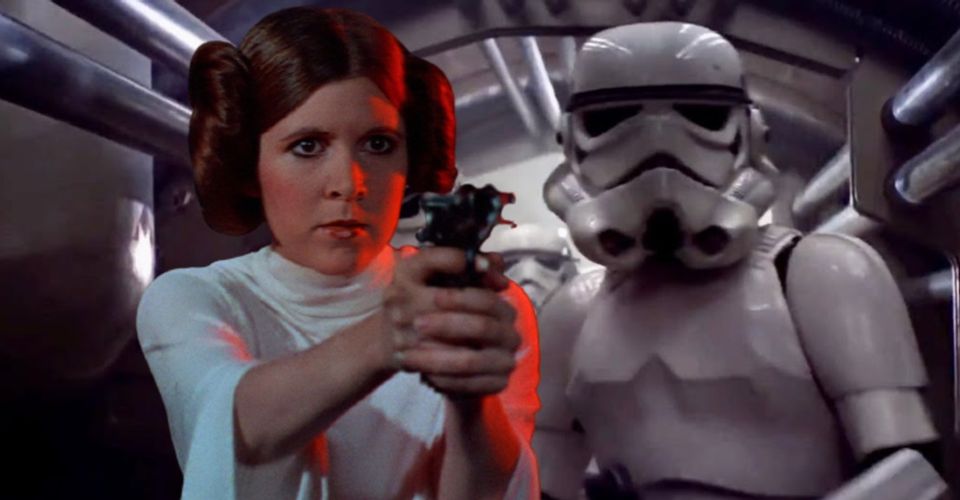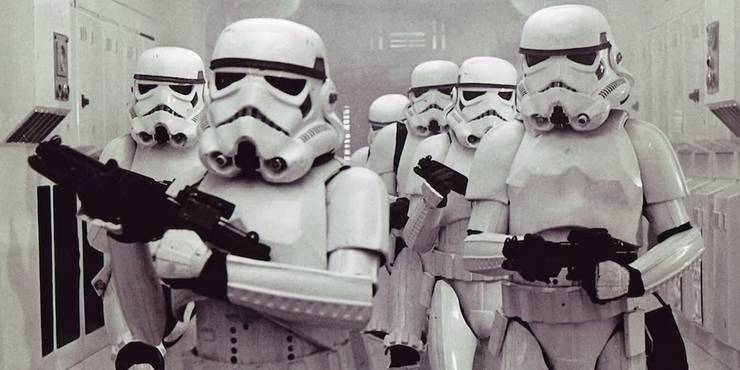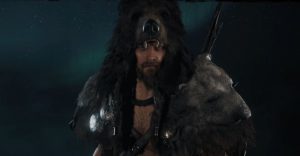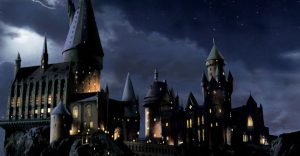Star Wars: Why Blasters Are Only Set to Stun Once for Leia in A New Hope

In the opening sequence of Star Wars, Princess Leia, whose ship has been overrun by Imperial forces, is captured by Stormtroopers after being incapacitated by a blaster set to stun – but this seldom occurs again. After A New Hope, this feature of the saga’s ubiquitous blasters is not seen again in the original or prequel trilogies but does show up once more in Star Wars: The Last Jedi. Blasters are seen set to stun many times in Star Wars’ non-movie material, however, in both canon and the original timeline, the Expanded Universe (now known as Legends). Stun is a demonstrably useful feature for blasters, so why is it so rarely seen in live-action films?
Blasters are one of the most common weapons in both Star Wars continuities, and they’re more complex than simple “laser guns.” With a variety of settings, features, and variants, blasters are energy weapons that fire bolts of irradiated gas (such as tibanna) that explode on contact with solids. Most of the blasters seen in the Star Wars franchise are armor-piercing, but more common civilian blasters cannot easily penetrate the armor worn by Stormtroopers or Clone Troopers. Blasters have various power settings, with low-power bolts being sufficient to instantly kill most humanoids while causing minimal damage to environments. Higher settings cause durable materials to melt or catch fire, and have the same effect on living beings, as seen in Star Wars: Episode III – Revenge of the Sith when Obi-Wan incinerated Grievous’ organs. As seen in Star Wars, The Empire Strikes Back, and 2003’s Star Wars: Clones Wars, the highest settings are extremely dangerous, with bolts that leave massive craters in durable walls and can obliterate droids and humanoids.
In addition to various power settings, blasters also have different firing modes. While “kill” is the most commonly-seen setting, blasters can also be set to “stun.” Stun is primarily used for capturing opponents, as it renders most humanoids unconscious by overloading their nervous systems. The same power settings that can be applied to blasters set to kill can also be applicable to stun bolts as well. Humanoids hit by stun bolts from blaster guns are rendered unconscious for only a few minutes, several hours, or sometimes blown across a room (and potentially injured), depending on the power setting. For such a useful feature, stun is seen so rarely in the films simply because nearly every battle in the films is a life-or-death scenario.

Leia needed to be taken alive at the beginning of Star Wars, so the Imperials used a non-lethal setting. Leia was evidently stunned with a low power bolt, as she was seen fully-recovered only a brief moment later. In The Last Jedi, the two sub-factions of the Resistance were battling for control of the Raddus – so naturally, neither side wanted to kill the other, since they were all still technically allies. Leia stuns Poe Dameron with a high-powered stun bolt, no doubt aware of how resourceful the mutineers’ leader is.
The franchise’s non-movie material featured far more situations where stun was useful. In the four-part season 5 finale of Star Wars: The Clone Wars, Ahsoka Tano is framed for a crime she didn’t commit. The Clone Troopers, in addition to respecting Ahsoka (and in some cases not believing her to be guilty), are under orders to take her alive, so every blaster bolt they fire at her is set to stun. In Legends, stun was the non-lethal weapon of choice for Imperials, but the setting was occasionally known to have adverse effects on its victims. Because of this, alternative weapons were sometimes used, such as the Stokhli spray stick wielded by Noghri Commandos in Heir to the Empire, or tranquilizer pistols, as used by a Nagai soldier to capture Leia in Marvel’s classic Star Wars comics.
- Rogue Squadron (2023)Release date: Dec 22, 2023
About The Author


















